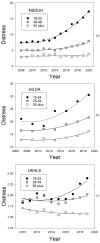Distress Signals: Age Differences in Psychological Distress before and during the COVID-19 Pandemic
- PMID: 36834239
- PMCID: PMC9964389
- DOI: 10.3390/ijerph20043549
Distress Signals: Age Differences in Psychological Distress before and during the COVID-19 Pandemic
Abstract
Psychological distress reached historically high levels in 2020, but why, and why were there pronounced age differences? We address these questions using a relatively novel, multipronged approach, part narrative review and part new data analyses. We first updated previous analyses of national surveys that showed distress was increasing in the US and Australia through 2017 and then re-analyzed data from the UK, comparing periods with and without lockdowns. We also analyzed the effects of age and personality on distress in the US during the pandemic. Results showed distress levels and age differences in distress were still increasing through 2019 in the US, UK, and Australia. The effects of lockdowns in 2020 revealed the roles of social deprivation and fear of infection. Finally, age-related differences in emotional stability accounted for the observed age differences in distress. These findings reveal the limitations of analyses comparing pre-pandemic and pandemic periods without accounting for ongoing trends. They also suggest that differences in personality traits such as emotional stability modulate responses to stressors. This could explain age and individual differences in both increases and decreases in distress in response to changes in the level of stressors such as those occurring prior to and during the COVID-19 pandemic.
Keywords: COVID-19 pandemic; age differences; psychological distress.
Conflict of interest statement
The authors declare no conflict of interest.
Figures



Similar articles
-
Emotional distress in young adults during the COVID-19 pandemic: evidence of risk and resilience from a longitudinal cohort study.Psychol Med. 2022 Apr;52(5):824-833. doi: 10.1017/S003329172000241X. Epub 2020 Jun 23. Psychol Med. 2022. PMID: 32571438 Free PMC article.
-
Psychological distress associated with the second COVID-19 wave: Prospective evidence from the UK Household Longitudinal Study.J Affect Disord. 2022 Aug 1;310:274-278. doi: 10.1016/j.jad.2022.05.025. Epub 2022 May 11. J Affect Disord. 2022. PMID: 35568319 Free PMC article.
-
Spirituality, Personality, and Emotional Distress During COVID-19 Pandemic in Croatia.J Relig Health. 2022 Feb;61(1):644-656. doi: 10.1007/s10943-021-01473-6. Epub 2022 Jan 7. J Relig Health. 2022. PMID: 34993678 Free PMC article.
-
The Impact of the COVID-19 Pandemic on Psychological Distress, Physical Activity, and Symptom Severity in Parkinson's Disease.J Parkinsons Dis. 2020;10(4):1355-1364. doi: 10.3233/JPD-202251. J Parkinsons Dis. 2020. PMID: 32925108 Free PMC article.
-
Greenspace and park use associated with less emotional distress among college students in the United States during the COVID-19 pandemic.Environ Res. 2022 Mar;204(Pt D):112367. doi: 10.1016/j.envres.2021.112367. Epub 2021 Nov 10. Environ Res. 2022. PMID: 34774510 Free PMC article.
Cited by
-
Age-related differences in delay discounting: Income matters.Psychol Aging. 2024 Sep;39(6):632-643. doi: 10.1037/pag0000818. Epub 2024 Apr 22. Psychol Aging. 2024. PMID: 38647450
-
Understanding the effect of stay-at-home orders on psychological distress during the COVID-19 pandemic: Evidence from a longitudinal study in Australia.PLoS One. 2025 Jul 2;20(7):e0325753. doi: 10.1371/journal.pone.0325753. eCollection 2025. PLoS One. 2025. PMID: 40601764 Free PMC article.
-
Navigating the Shadows of Others' Traumas: An In-Depth Examination of Secondary Traumatic Stress and Psychological Distress among Rescue Professionals.Behav Sci (Basel). 2023 Dec 27;14(1):21. doi: 10.3390/bs14010021. Behav Sci (Basel). 2023. PMID: 38247673 Free PMC article.
References
-
- Aknin L.B., De Neve J.-E., Dunn E.W., Fancourt D.E., Goldberg E., Helliwell J.F., Jones S.P., Karam E., Layard R., Lyubomirsky S., et al. Mental Health During the First Year of the COVID-19 Pandemic: A Review and Recommendations for Moving Forward. Perspect. Psychol. Sci. 2022;17:915–936. doi: 10.1177/17456916211029964. - DOI - PMC - PubMed
-
- Murthy V. Protecting Your Mental Health: The U.S. Surgeon General’s Advisory. U.S. Department of Health & Human Services; Washington, DC, USA: 2021. [(accessed on 27 January 2022)]. p. 53. Available online: https://www.hhs.gov/
Publication types
MeSH terms
Grants and funding
LinkOut - more resources
Full Text Sources
Medical

